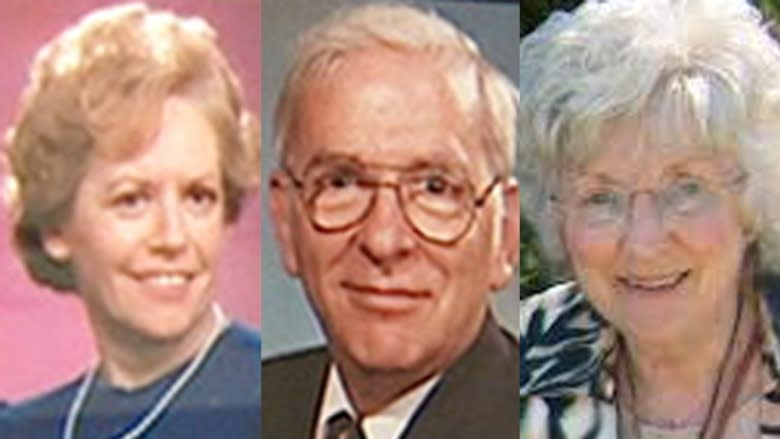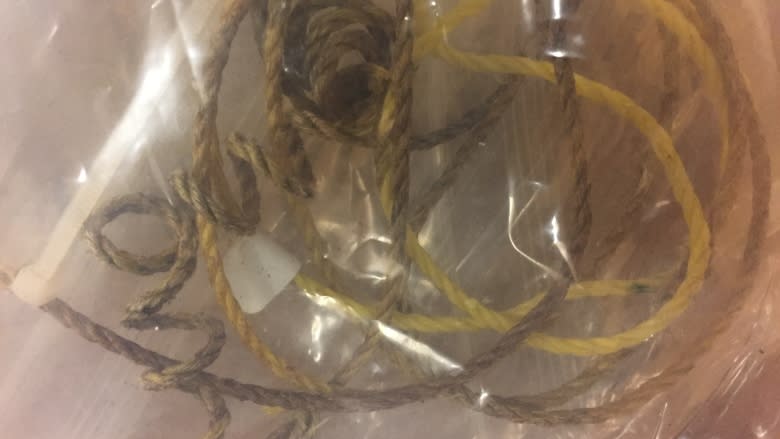Ian Bush trial: Tax judge strangled, suffocated, beaten, coroner testifies
Retired tax court judge Alban Garon, who was 77 years old, suffered the worst of it.
His wife, 73-year-old Raymonde Garon, and their friend, 78-year-old Marie-Claire Beniskos, suffocated to death, hog-tied, with plastic bags placed over their heads.
A small joint in Raymonde Garon's left shoulder was fractured and dislocated, likely caused by being taken to the ground to be tied up, and seven of Beniskos' right ribs were fractured, likely the same way, according to Dr. Michael Pollanen, Ontario's chief forensic pathologist and deputy chief coroner, who performed the autopsies.
But whoever killed Alban Garon injured him more seriously, Pollanen told the jury Wednesday at the first-degree murder trial of Ian Bush.
Alban Garon's arms and wrists were bound, though he wasn't hog-tied like the others. Instead, a yellow nylon "hangman's noose" was wound tightly around both his neck and a clear plastic bag that covered his head.
He died of ligature strangulation, suffocation in a plastic bag and blunt force head trauma powerful enough to fracture his skull, Pollanen testified.
Graphic autopsy photos of the three victims — found dead in the Garons' luxury condo on Riverside Drive in June 2007 — were shown to the jury, made up of 11 men and one woman.
Bush, 61, was charged in 2015 with three counts of first-degree murder and has pleaded not guilty.
Sitting in the glass-walled prisoner's box Wednesday, Bush, wearing a black suit and glasses, studiously took notes on a yellow pad of lined paper.
'Damage to all layers of his head and brain'
The trauma to Garon's head was centred in the area of his right ear, causing the cartilage to break, Pollanen testified. There was significant tissue damage as well as a skull fracture, with some smaller radiating fractures, he added.
Garon's brain was also jostled enough that the thin occipital bones on top of his eyes were broken, Pollanen told the jury.
A tear in the bag in the same ear area indicates the trauma occurred while the bag was over Garon's head.
"When you put all of that together, we're talking about a heavy blow or blows to his head that caused damage to all layers of his head and brain," Pollanen testified.
There were also signs Garon struggled against his restraints while he was alive, Pollanen told the jury.
Heavy metal bar found in home
Prosecutor James Cavanagh then entered a heavy, black metal bar into evidence, saying it was found in Bush's home. Cavanagh asked Pollanen whether it could have been used to inflict Alban Garon's head injuries.
Pollanen said it can't be ruled out.
In cross examination, defence lawyer Geraldine Castle-Trudel asked Pollanen whether he could say what caused the blunt force head injuries.
Pollanen testified they could be caused either by Garon's head slamming forcefully into something flat, or from an object that doesn't have sharp edges. He again repeated he can't be sure the black metal bar caused the injuries, saying only that it can't be ruled out.
He also testified that Raymonde Garon appears not to have struggled against her restraints, while the other two had injuries consistent with doing so.
Crown witness Nancy Bouillon, a property manager who worked at the condo complex in 2007, then resumed testimony she began last week about the security features of the gated luxury condo complex.
OC Transpo surveillance video
Last week, the jury saw surveillance videos purportedly depicting Bush walking from the Hurdman OC Transpo station toward the Garons' condo on the day of the killings, and then returning to the station an hour later.
Bush's son identified the man in the video as his father, pointing out his distinctive gait and fanny pack.
The Crown also introduced a photo of a shirtless Bush doing pushups on his fingertips, which also shows a pair of white running shoes in the rear corner. Inside the Garons' apartment, police found a footprint that matched a pair of New Balance 504 running shoes.
The trial continues Thursday with testimony from Sgt. James Killeen, a forensic identification officer.





